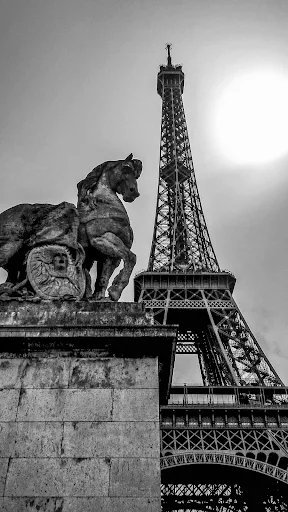The Eiffel Tower, one of the most recognizable landmarks in the world, stands as a symbol of France’s rich history, architectural brilliance, and cultural significance. Situated in the heart of Paris, this iron lattice tower attracts millions of visitors every year. From its controversial origins to its current status as a global icon, the Eiffel Tower has an incredible story to tell.
In this article, we’ll explore the history, architecture, interesting facts, and tourism significance of the Eiffel Tower.
History of the Eiffel Tower
The Vision Behind the Tower
The Eiffel Tower was constructed as the centerpiece of the 1889 Exposition Universelle (World’s Fair) held in Paris. The event was meant to celebrate the 100th anniversary of the French Revolution and showcase France’s industrial progress. The French government wanted an extraordinary structure to represent modern engineering and innovation.
Gustave Eiffel, a renowned engineer, took up the challenge. His company, Eiffel & Cie, designed and built the tower, which would later bear his name. However, the project faced opposition from many artists and intellectuals who believed it was an eyesore that would ruin the beauty of Paris.
Construction and Completion
Construction of the Eiffel Tower began on January 28, 1887, and was completed in just two years, two months, and five days—a remarkable achievement for the time. The tower was officially inaugurated on March 31, 1889, and opened to the public on May 6, 1889.
The structure was built using 18,038 iron parts and required 2.5 million rivets to hold it together. At 330 meters (1,083 feet) tall today, it was the tallest man-made structure in the world at the time of its completion, surpassing the Washington Monument in the United States.
Architectural Brilliance of the Eiffel Tower
The Eiffel Tower’s unique iron lattice design was revolutionary. It combined strength, stability, and elegance while being lightweight compared to traditional stone structures.
Key Architectural Features
Material: Made of wrought iron, the tower’s total weight is approximately 10,100 tons.
Structure: It consists of four massive pillars that curve inward and meet at the top, creating a triangular shape.
Wind Resistance: Despite its height, the design allows the tower to sway up to 7 cm in strong winds.
Height: Originally 312 meters, it has grown to 330 meters today due to the addition of antennas.
Lighting System: The tower sparkles with 20,000 twinkling lights every evening, making it a breathtaking sight at night.
The design of the Eiffel Tower later influenced modern skyscraper construction, proving that metal structures could be both functional and artistic.
Eiffel Tower and Its Role in History
Early Controversies
Many Parisians were initially against the tower, calling it the “Iron Monster.” A group of prominent artists and writers, including Guy de Maupassant, signed a petition demanding its removal. However, Gustave Eiffel defended his creation, emphasizing its engineering marvel and artistic beauty.
The Tower’s Importance in World War I
During World War I, the Eiffel Tower played a critical role in communication. The French military installed a radio transmitter at the top, which helped intercept enemy messages, contributing to important victories.
Survival During World War II
During World War II, Nazi Germany occupied France, and Adolf Hitler ordered the tower to be destroyed. However, the command was never carried out, and instead, French resistance fighters cut the tower’s elevator cables to prevent Nazi officers from accessing the top.
Today, the Eiffel Tower is a symbol of France’s resilience and cultural pride.
Tourism and Visitor Experience
Why Do Millions Visit the Eiffel Tower?
The Eiffel Tower is the most visited paid monument in the world, welcoming over 6 million visitors annually. Tourists come to admire its beauty, learn its history, and enjoy panoramic views of Paris.
Levels of the Eiffel Tower
The Eiffel Tower has three visitor levels:
First Floor
Features a glass floor offering a thrilling view beneath.
Houses exhibition areas and restaurants.
Second Floor
Offers spectacular views of Parisian landmarks like Notre-Dame Cathedral, the Seine River, and the Louvre Museum.
Home to the famous Le Jules Verne Restaurant.
Third Floor (Summit)
Stands at 276 meters (906 feet) and provides a breathtaking 360-degree view of Paris.
Contains a recreation of Gustave Eiffel’s office.
Best Time to Visit
Daytime: Offers clear views of the city’s landscape.
Sunset: The golden hour creates a magical atmosphere.
Night: The tower’s twinkling lights shine every hour after sunset.
Interesting Facts About the Eiffel Tower
It was almost demolished: The tower was supposed to be removed after 20 years, but its usefulness in radio transmission saved it.
It changes height: Due to thermal expansion, the tower expands by about 15 cm (6 inches) in summer.
It has hosted stunts: People have attempted parachute jumps, tightrope walks, and even bicycle stunts from the tower.
It was once the tallest structure in the world: It held this record until the Chrysler Building in New York surpassed it in 1930.
It gets repainted every seven years: This maintenance process requires 60 tons of paint to prevent rust.
The Eiffel Tower in Popular Culture
The Eiffel Tower has appeared in countless films, books, and advertisements, making it a symbol of romance and adventure. Movies like Midnight in Paris, The Da Vinci Code, and Ratatouille showcase the tower’s cinematic charm.
Additionally, many couples choose the Eiffel Tower as a proposal spot, making it a symbol of love and romanceworldwide.
Conclusion
The Eiffel Tower is more than just an architectural wonder; it is a testament to human creativity, engineering, and cultural heritage. From its controversial beginnings to its modern-day popularity, it has stood the test of time as a beloved landmark of Paris and the world.
Whether you admire it for its historical significance, breathtaking views, or dazzling lights, the Eiffel Tower continues to inspire millions of visitors each year. If you ever visit Paris, this masterpiece is a must-see attraction that captures the heart of the City of Light.





No comments:
Post a Comment